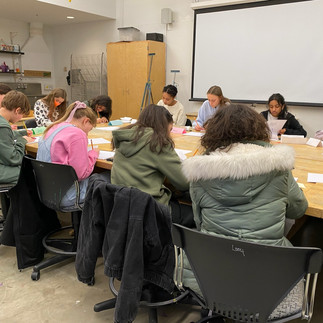Getting to know one another.
- Makalla Shernick

- Feb 25, 2023
- 4 min read
Saturday, February 25, 2023
This past Saturday marked the first day of Art Explorations; a visual arts course designed for secondary students in the Mason Community Arts Academy (MCAA). The eight-week course—reoccurring on Saturday mornings for an hour and a half—is being taught by myself and my friend/colleague Caroline Harding. Both her and I are concurrently BFA and MAT students at George Mason University. Our interests in topics in art education are similar, but often our approaches to our own artmaking and teaching art differ greatly. Our different backgrounds—mine being in graphic design and hers in painting—has brought out the “best of both worlds” so to speak for our design of this semester’s curriculum. One thing to note here is that every semester’s curriculum of the visual arts classes through MCAA is entirely designed by the lead teacher of that class. Being that MCAA is a George Mason affiliated organization, the role of lead instructor is given and accepted by a current student in the MAT Art Education program. It’s a symbiotic system that breathes life into the programs. In fact, its concept is, in part, inspiration for the theme and/or question Caroline wanted to explore while teaching this semester.
How do community arts initiatives or programs inspire emerging and non-traditional approaches to artmaking? How might students exhibit growth after engaging in artmaking that exceeds the confines of a traditional art classroom?
My intention for this blog is to serve both as record and reflection of my experiences while teaching this 2023 Spring semester of Art Explorations. Our enrollment, as of the first day of class, is at full capacity with 16 students. I might note if this changes, but I am not expecting it to.
Our first day was crucial in establishing an open dialogue with students. A large portion of our time was dedicated to introducing ourselves to our students, allowing our students to introduce themselves, and finally introducing the space of our classroom. Care was given in showing students where materials would be available, where hands could be washed, and where their work could be stored. Introducing boundaries and expectations within the classroom is intended to give students autonomy while they are engaging in, what I will often refer to as, Saturday Studio. We asked students to tell us their name, their preferred pronouns, and what animal they would be if they were one. Apart and separate from the surprisingly great insight about our students gleaned from the animal question, our other criteria for introduction gave our students the freedom to verbalize how they would like to be addressed. I noticed a couple of my students, after our introductions, decided to change the birth name they had previously wrote on their name ‘tents’ to one that reflected their preferred name and/or gender.
Spliced into our introduction phase of class, we had students complete an identity map and a pre-assessment survey. The identity map is an explicit attempt at getting students to generate ideas right away that they may refer to later for inspiration when ideating their projects. The pre-assessment survey included questions about their thoughts, feelings, and expectations regarding art. We crafted these survey questions to get to know the students better, and to have another metric of possibly assessing their growth by the end of course.
The first project was introduced this day as well. Students engaged in the medium of Zines. After giving a brief overview of the “zine-story,” we took a field-trip to the book shelves outside of the print studio in the art building that showcases the Zines made by students at George Mason. I believe that students gained a good amount of inspiration from this excursion. One student noted that they liked how “abstract” one of the Zines was. Another said that they were intrigued by a Zine that only had images. I think both of these comments are indicative of the expectations the students had when introduced to the idea of Zines, in that they took particular notice of the Zines that was not reflective of an expected format or content.
When we got back to the classroom, Caroline led a great demo that gave the option for students to use three different formats for their own Zine. Then, they were introduced to their “Zine Challenge.” Which is to make a Zine using one sheet of letter sized paper and black ink. The purpose of this challenge is to have students engage in the idea of self-publishing. We reminded students to create something that holds meaning they want to share. For their final exhibition at the end of the semester, they will have multiple ‘published’ copies of their Zines to share with their friends and family. All of the students were immediately engaged in creating their zines until they had to clean up in the last couple of minutes of class. The range of content being created by these students was not only impressive, but is also beneficial for me to understand more about their personalities and interests. A couple of students finished their zine, but many still need to go over their pencil sketches with black ink. They will have the next few weeks to finish those during those ‘in-between’ moments of our classes.









Comments